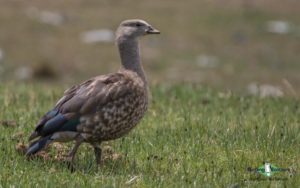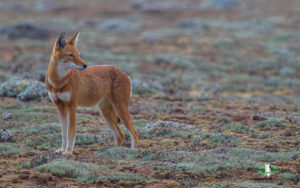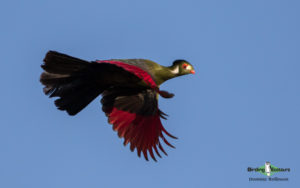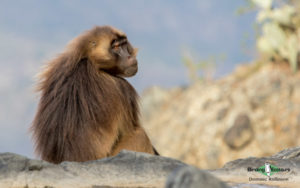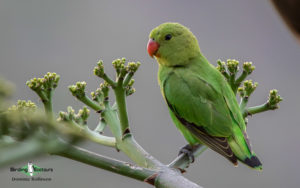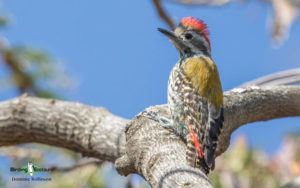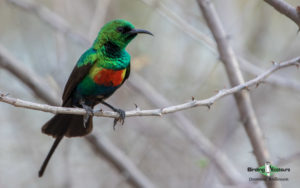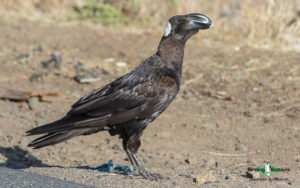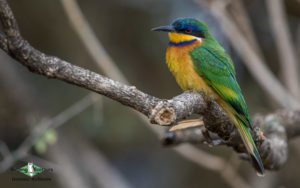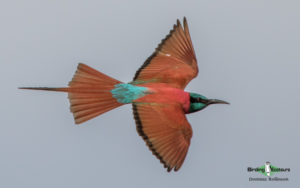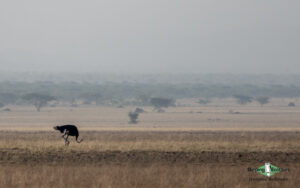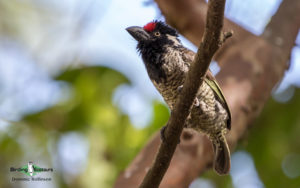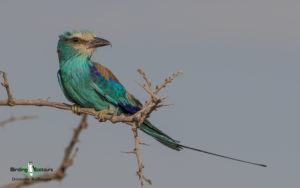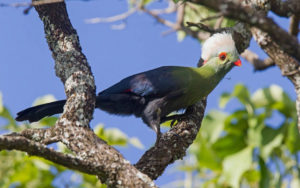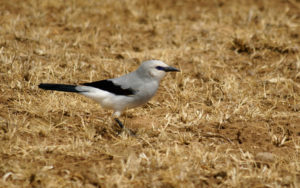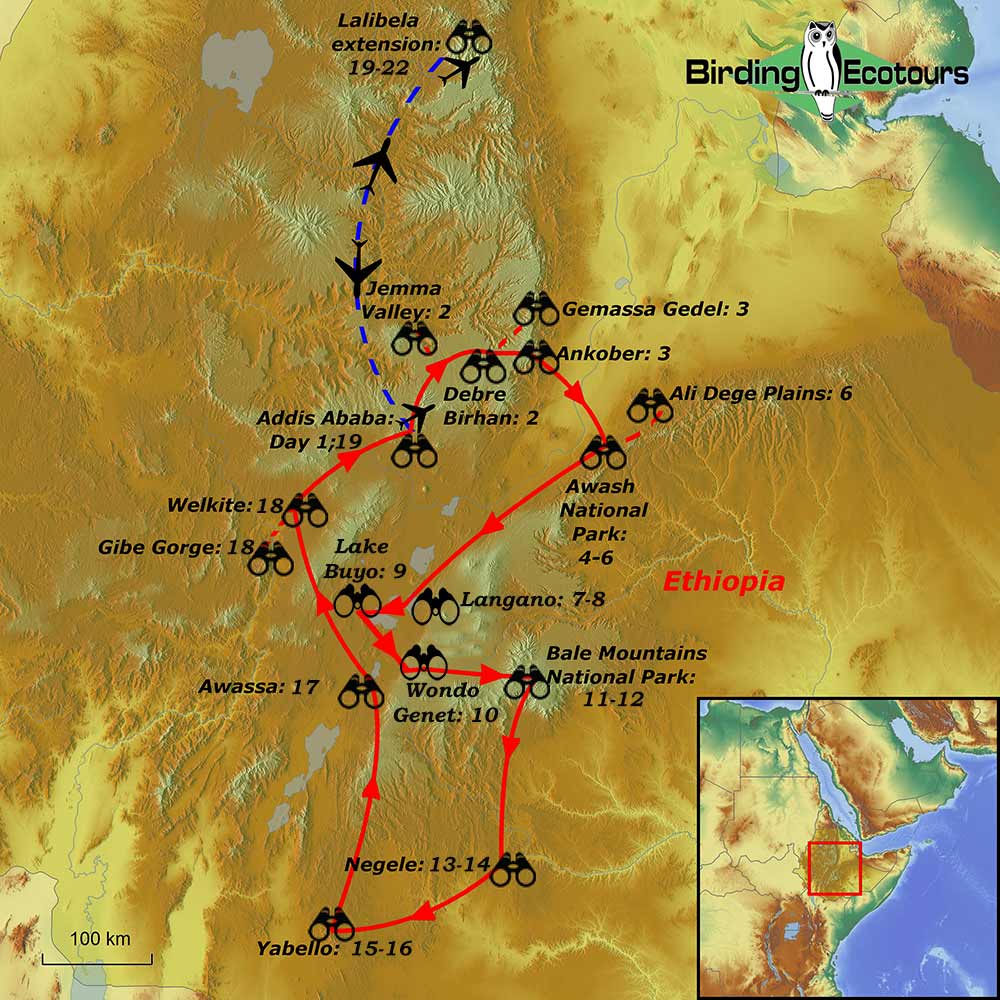Birding Tour Ethiopia: Complete Abyssinia
Go to: Ethiopia Birding Tours | Lalibela Historical Extension | Birding Tours in Africa | All our birding tours
Ethiopia: Complete Abyssinia
March 2026
Our birding tour to Ethiopia, “the Roof of Africa”, is an absolutely unique and spectacular birding experience. Ethiopia is one of Africa’s most scenically beautiful countries, boasting some of the continent’s highest mountains and plateaus (but also contains a depression that reaches slightly below sea level), impressive escarpments, Great Rift Valley lakes and volcanoes, and highly varied vegetation from juniper forests to arid savanna dotted with monstrous red termite mounds. Descending from the highlands to the deep valleys far below can seem like entering a completely different world, all within the same day – it is such an amazingly varied country.
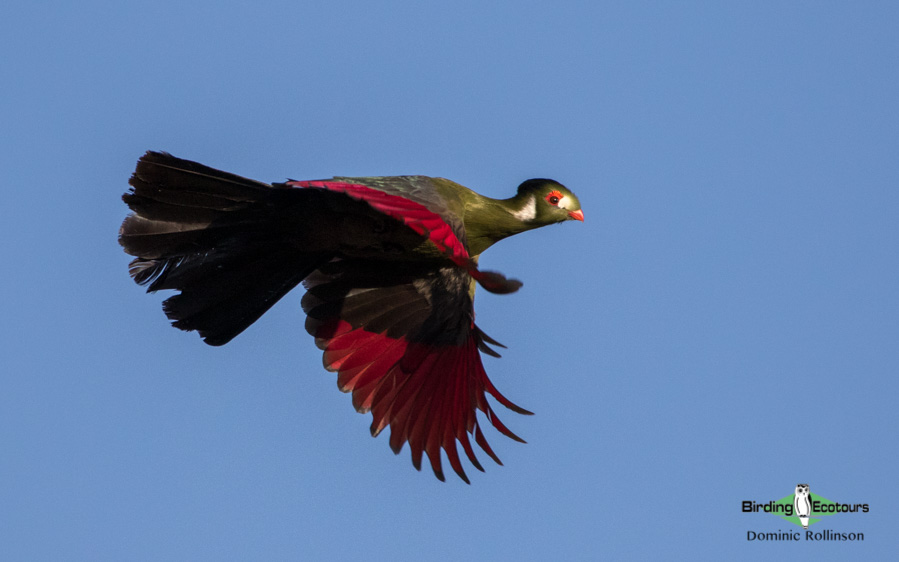
Our Ethiopia birding tours visit Ethiopia’s unique mountain topography situated in the middle of the “Horn of Africa” which is not just stunningly scenic but also produces an impressive number of endemic birds (about 20 species) found in no other country. This is in addition to a lot of near-endemic bird species that are most easily found in Ethiopia – especially since other countries in north-east Africa are currently considered unsafe to visit. The list of Ethiopian endemics includes the spectacular Ruspoli’s Turaco, the striking, bizarre, and taxonomically puzzling Stresemann’s Bushcrow, and Archer’s (Liben, Sidamo) Lark, which is sadly considered the next bird likely to probably go extinct in Africa.
On this Ethiopian birding tour, we will target all of the Ethiopian bird endemics as well as a number of Horn of Africa endemics, which are also found in some of Ethiopia’s neighboring countries. Ethiopia is also one of the best places to see birds such as Arabian Bustard, with luck having Northern Carmine Bee-eaters riding on their backs. Ethiopia’s birds are generally easy to find, and in addition to the plethora of endemics it is not too difficult to end up with an impressive bird list of around 500 species after a two-and-a-half-week trip to this country.
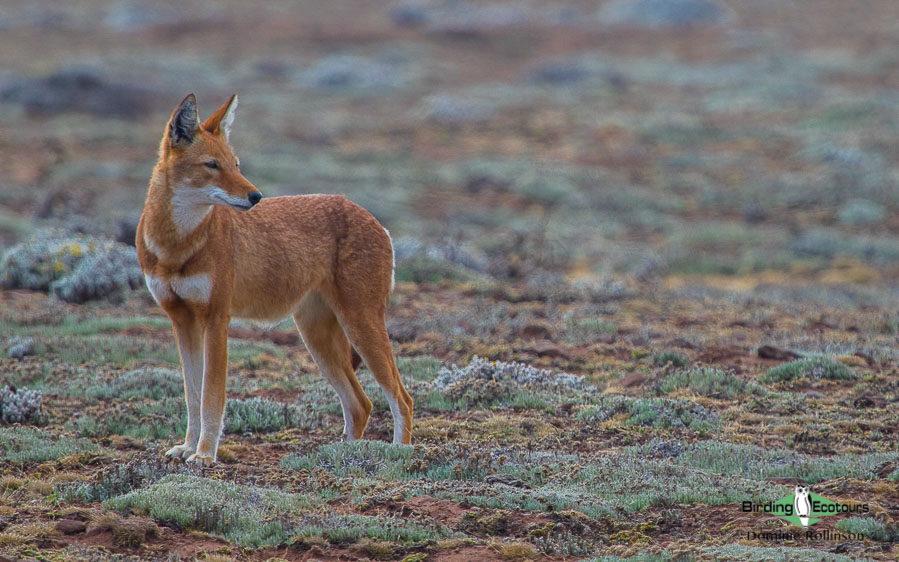
Ethiopia of course also boasts such fabulous mammals as Ethiopian Wolf, some awesome primates including Gelada and Hamadryas Baboons, the regal-looking Beisa Oryx, rare Grevy’s Zebra, and many others. The country also has a spectacularly rich and ancient history, and all in all is a wonderful country to travel in.
If you would like to further extend your time in this fascinating country, you can join our short Lalibela Cultural Extension, where we visit one of Ethiopia’s most sacred places. Here, we will spend time enjoying the impressive monolithic rock churches carved out of the basalt bedrock and acquire a better understanding of the area’s rich history and culture. We will of course be on the lookout for any interesting birds too.
Itinerary (19 days/18 nights)
Day 1. Addis Ababa
Our 19-day Ethiopia birding tour starts in the fascinating high-altitude city of Addis Ababa, which has a population of about four million people. Here we can already find many of Ethiopia’s more common endemics and near-endemics, such as the oddly proportioned Thick-billed Raven, White-collared Pigeon, Banded Barbet, Wattled Ibis, Abyssinian Slaty Flycatcher, Black-winged Lovebird, Brown-rumped Seedeater, and others. In the evening we will enjoy our first traditional Ethiopian meal and might even find a Montane Nightjar in the hotel grounds.
Overnight: Ghion Hotel, Addis Ababa
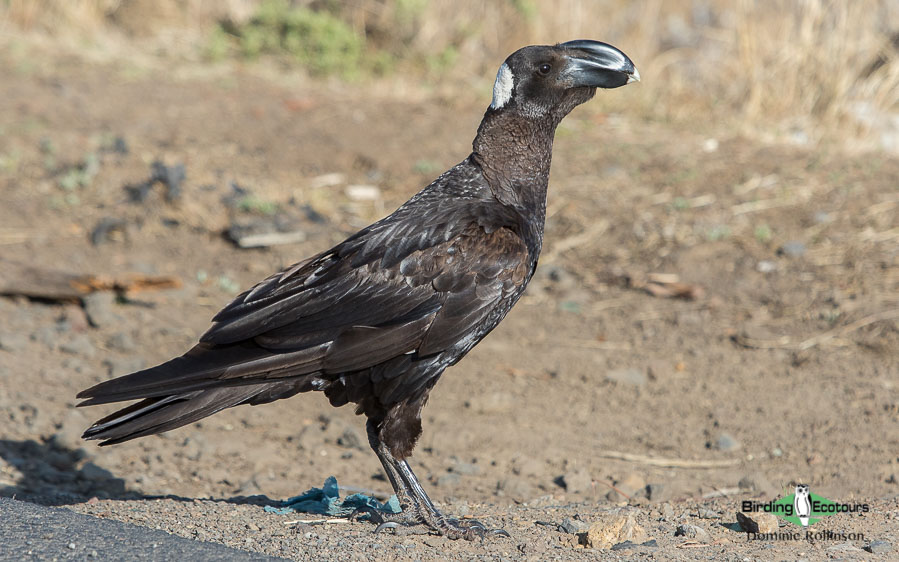
Day 2. Birding the Jemma River
Today we will have a very early pre-dawn start and head north to the Jemma Valley where we will enter a truly different world. We will aim to arrive on the edge of the valley to look for some of Ethiopia’s localized endemics and near-endemics, such as Harwood’s and Erckel’s Spurfowls, Rüppell’s Black Chat and others. We then descend from dizzying heights to the Jemma River far down below us and enter an arid land, where we look for a very different suite of birds compared to those of the central Ethiopian highlands. Here, we will look for species such as Speckle-fronted Weaver, Fox Kestrel, Foxy and Short-winged Cisticolas, Abyssinian Wheatear, Senegal Thick-knee, Black-billed Barbet, Abyssinian Ground Hornbill, and many others characteristic of East Africa’s arid areas. Later in the day we will head back out of the impressive Jemma Valley and make our way back into the highlands, this time to Debre Birhan, where we are based for the night.
Overnight: Getva Hotel, Debre Birhan
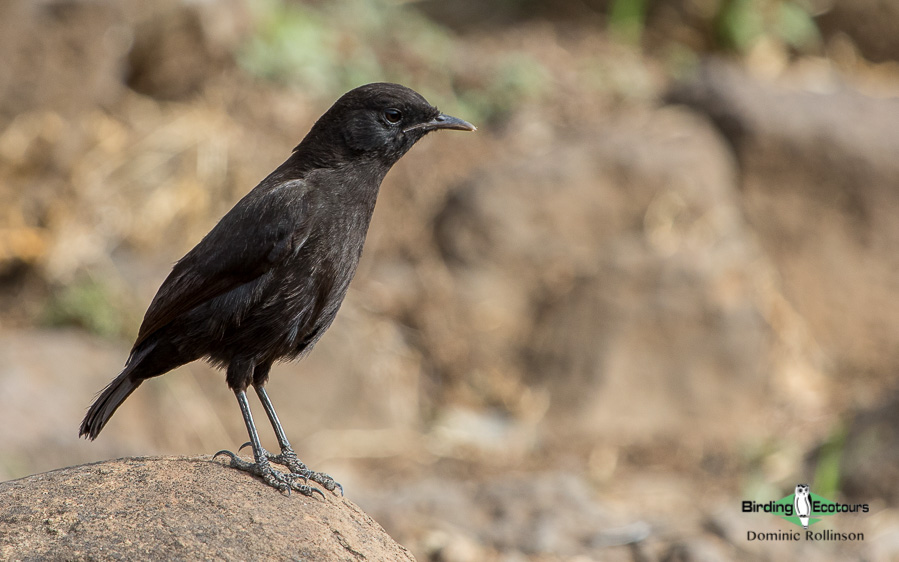
Day 3. Searching the escarpment for Ankober Serin
Among many other things today, we will reach impressive heights at the Gemassa Gedel and Ankober escarpments to search for an extremely localized bird, the endemic and Vulnerable (BirdLife International) Ankober Serin which was described to science as recently as 1976. Although our main target species is unlikely to dazzle you, it can however be described as ‘subtly beautiful’ and the scenery here is simply spectacular, with beautiful mountains overlooking distant valleys. Other avian targets to look out for in the area include White-billed Starling, Blanford’s Lark, Abyssinian Longclaw, Ethiopian Siskin, and large impressive predators like Verreaux’s Eagle or Bearded Vulture. We also hope to find our first Geladas (nicknamed “bleeding-heart monkeys”); these ferocious-looking but vegetarian baboons have huge vocabularies and a complex social system.
We then continue towards Ankober where we will continue birding the highlands and escarpment, where we might encounter Rufous-breasted Sparrowhawk, Somali Crow, Hemprich’s Hornbill, Nyanza and Mottled Swifts, Rüppell’s Black and Moorland Chats, White-rumped Babbler, Abyssinian and Rusty-breasted Wheatears, Yellow-crowned Canary, and many other exciting species.
Overnight: Ankober Palace Lodge, Ankober
Day 4. Transfer to Awash National Park, birding Melka Ghebdu en route
We will descend the escarpment today and likely have our breakfast stop in Melka Ghebdu, a dry river bed where the Ethiopian endemic Yellow-throated Seedeater occurs. We will concentrate on the seedeater but may also find White-bellied Go-away-bird, Abyssinian Roller, Common Rock Thrush, White-throated Robin, Beautiful Sunbird, Sahel Bush Sparrow, Crimson-rumped Waxbill, and many other dry-country species.
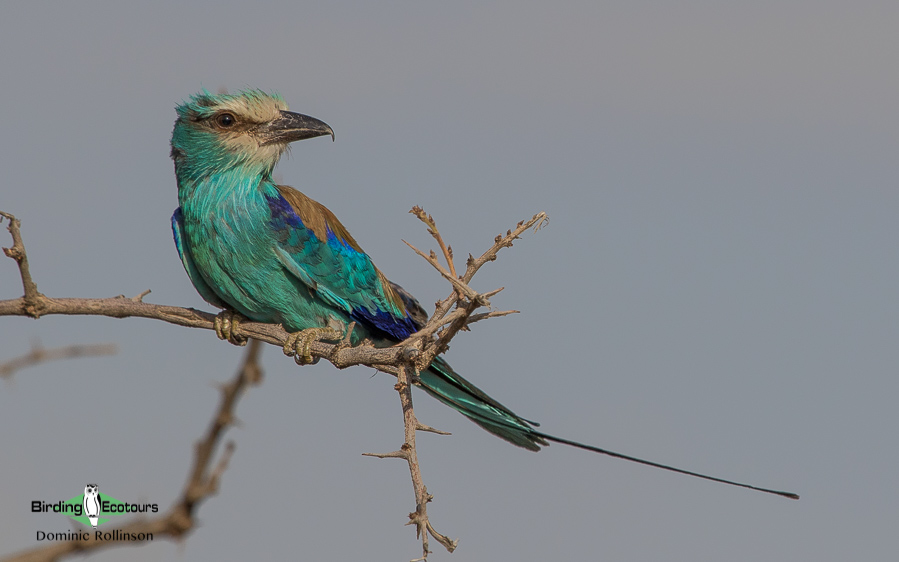
From here, we will drive through some of Ethiopia’s most remote country, to get to Awash National Park. If the road is good, after gathering up-to-date information, we will bird the amazing Afar Plains, where a rich diversity of birds will likely make an appearance. We could see Yellow-necked Spurfowl, Kori Bustard, Black-headed Lapwing, Chestnut-bellied Sandgrouse, Red-bellied Parrot, Bare-faced Go-away-bird, Blue-naped Mousebird, Olive Bee-eater, Abyssinian Roller, Black-billed Wood Hoopoe, Abyssinian and Black Scimitarbills, various hornbill species including Abyssinian Ground and Von der Decken’s Hornbills, Black-throated and Yellow-breasted Barbets, Black-crowned Sparrow-Lark, Grey Wren-Warbler, Grey-headed Batis, Slate-colored Boubou, Rosy-patched Bushshrike, Chestnut Weaver, and White-crested Helmetshrike, among many others. In the late afternoon we will arrive in the Doho area.
Overnight: Doho Lodge, Awash
Day 5. Birding Awash National Park
Awash is one of Ethiopia’s premier national parks, which has a rich diversity of birds as well as mammals. We’ll look for Scissor-tailed Kite, a host of bustards including Arabian, Buff-crested, Hartlaub’s, Black-bellied, and White-bellied Bustards, Bruce’s Green Pigeon, and many more. During our time here we also hope to find Somali Ostrich, African Collared Dove, Horsfield’s Bush Lark, Gillett’s Lark, Chestnut-backed and Chestnut-headed Sparrow-Larks, Boran and Ashy Cisticolas, Eastern Olivaceous Warbler, Pale and African Grey Flycatchers, Mouse-colored Penduline Tit, four of Africa’s most lovely sunbirds, namely Eastern Violet-backed, Nile Valley, Beautiful, and Shining Sunbirds, Somali Fiscal, Woodchat Shrike, Northern Masked Weaver, Cut-throat Finch, and many others. At this time of year we might also enjoy migrant Common Whitethroat and White-throated Robin. As always, raptor-watching will be spectacular – we can easily find 40+ species on our two-and-a-half-week tour, and many of these are in Awash National Park.
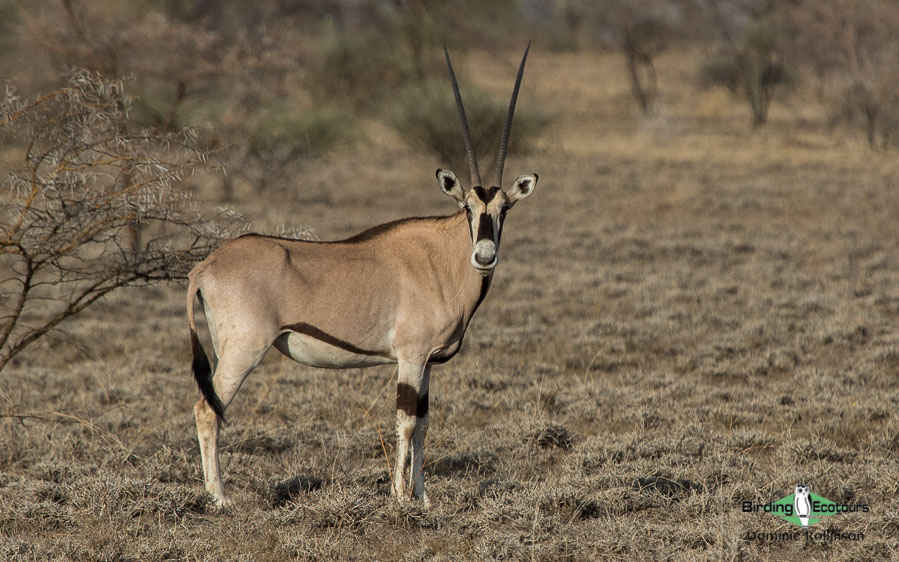
In the evening we will do a night drive, where we hope to find several nightjar and owl species, including Star-spotted, Slender-tailed, Plain, and Nubian Nightjars and perhaps Greyish Eagle-Owl and Northern White-faced Owl.
Overnight: Doho Lodge, Awash
Day 6. Birding Awash National Park and the Ali Dege Plains
Today we drive to the swelteringly hot Ali Dege Plains, where we should have some fantastic bird and mammal sightings. On the plains we may come across Arabian and Kori Bustards, Somali Ostrich, and Secretarybird, with large numbers of Chestnut-bellied Sandgrouse in the area too. We’ll keep a lookout for raptors, including Scissor-tailed Kite, Egyptian Vulture, Grasshopper and Long-legged Buzzards, as well as migrant eagles. Larger mammals to look out for here include Grevy’s Zebra, Beisa Oryx, Soemmerring’s Gazelle, African Golden Wolf, and perhaps the strange Gerenuk. In the surrounding bush we will search for African Collared Dove, Isabelline Shrike, Rosy-patched Bushshrike and many others.
Overnight: Doho Lodge, Awash
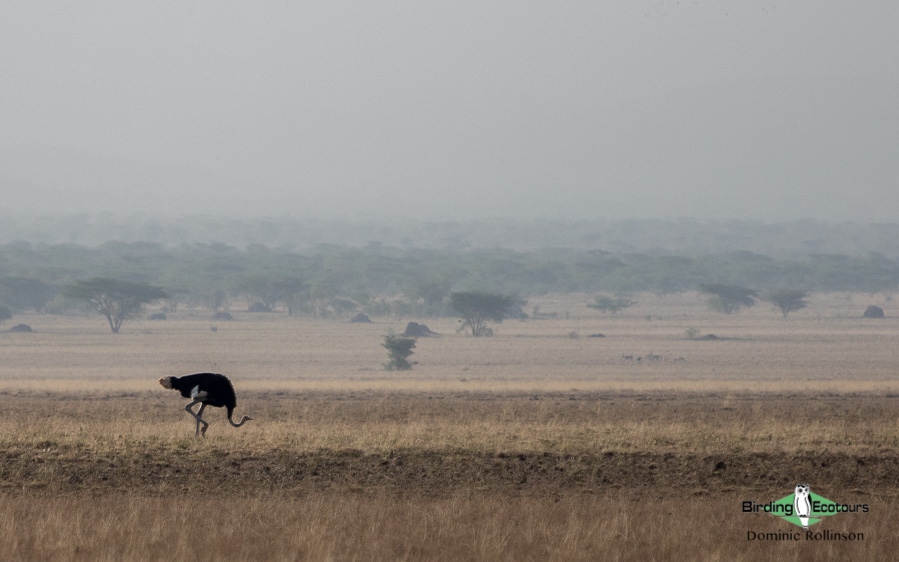
Day 7. Birding the Great Rift Valley lakes
After some final Awash birding, today we drive to Lake Langano, where we will spend the next two nights. We will bird this and other lakes, among them the beautiful Lake Ziway, and wetland sites of the Great Rift Valley, looking for Black Crowned Crane, Collared Pratincole, African Snipe and several other shorebird species, various tern species including Gull-billed Tern, Lesser and African Jacanas, Fulvous Whistling Duck, African Pygmy Goose, Western Marsh Harrier, and many others. Other highlights today might include Greater Spotted Eagle, Egyptian Vulture, White-headed Vulture, Clapperton’s Spurfowl, Blue-spotted Wood Dove, Lichtenstein’s Sandgrouse, Buff-bellied Warbler, Blackstart, Western Black-headed and Pygmy Batises, the striking Masked Shrike, Green-winged Pytilia, and Red-fronted Prinia, as well as many others.
Overnight: Sabana Beach Resort or similar, Langano
Day 8. Birding around Lake Langano and the Bishangary area
Some of the species we might find today are Black-winged Lovebird, Banded and Red-fronted Barbets, Little Weaver, and Little Rock Thrush. The rocky escarpment above the hotel holds Ethiopian Bee-eater, Mocking Cliff Chat, Abyssinian Wheatear, Fan-tailed Raven, and groups of cute Rock Hyrax. Alternatively, a walk in the adjacent dry acacia woodland might yield Black-billed Wood Hoopoe, Bearded Woodpecker, Von der Decken’s Hornbill, Boran Cisticola, Buff-bellied Warbler, Mouse-colored Penduline Tit, White-winged Black Tit, White-rumped Babbler, Grey-headed Batis, and Rüppell’s Weaver. Later on we may visit the grounds of another hotel for roosting Slender-tailed Nightjar and Verreaux’s and Greyish Eagle-Owls, as well as Clapperton’s Spurfowl.
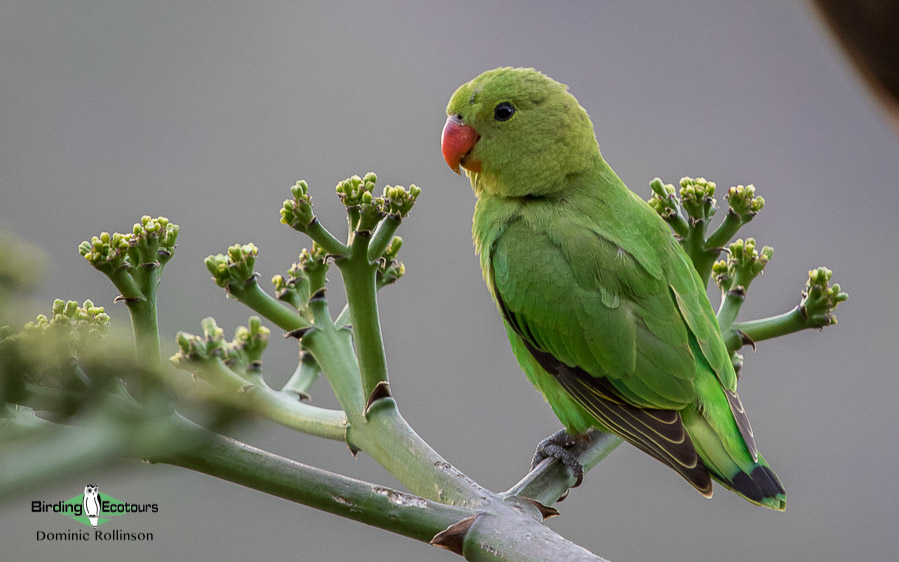
During the afternoon we plan to visit the forest around Bishangari on the southeastern shore of the lake. The acacia woodland along the road could produce Western Banded Snake Eagle, Bare-faced Go-away-bird, and Red-throated Wryneck, among others. The remnant patch of natural forest at Bishangari Lodge is home to several endemic and special birds, including Scaly Spurfowl, Lemon Dove, Narina Trogon, Silvery-cheeked Hornbill, Yellow-fronted Parrot, White-cheeked Turaco, Abyssinian Woodpecker, and Ethiopian Oriole. Noisy groups of Grey-backed Fiscals inhabit the more open areas, and Guereza can be found in tall fig trees.
Overnight: Sabana Beach Resort or similar, Langano
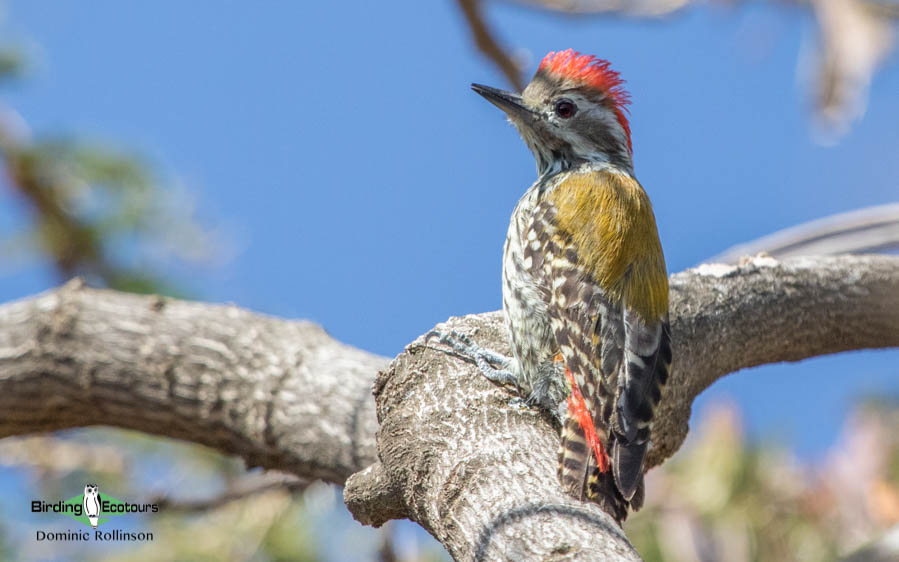
Day 9: Birding Lake Buyo
We will leave Langano early in the morning and head towards the town of Halaba Kulito. We will then drive around 25km north of Halaba Kulito to Lake Buyo to target Wattled Crane, this lake being one of Ethiopia’s most reliable sites for this most-wanted and gigantic crane species. At Lake Buyo it is also possible to find Black Crowned Crane, a host of water birds and many Palearctic migrants too.
Overnight: Sera Lodge, Halaba Kulito
Day 10. Transfer to Wondo Genet
After further birding around the various lakes we drive up the eastern escarpment of the Rift Valley to the hot springs of Wondo Genet. On our way to Wondo Genet, we may encounter White-winged Black Tit, Grey-backed Fiscal, and migrant Common Nightingale. In a forest patch near to Wondo Genet itself we look for awesome forest and woodland birds such as Yellow-fronted Parrot, Banded Barbet, Black-winged Lovebird, Abyssinian Ground Thrush, Abyssinian Woodpecker, Ethiopian Boubou, Brown Woodland Warbler, Narina Trogon, and Scaly-throated Honeyguide. Also in this area we might find the massive Silvery-cheeked Hornbill, dainty Mountain Wagtail, and the beautiful Red-shouldered Cuckooshrike.
Overnight: Wabi Shebele Hotel, Wondo Genet
Day 11. Birding Bale Mountains National Park
This morning we drive to Dinsho, the gateway to the fabled Bale Mountains, which reaches an altitude of around 14,000 feet (4,500 meters). Here we spend the next two days birding varied habitats for such sought-after species as Abyssinian Owl, Cape (Mackinder’s) Eagle-Owl (the largest of three subspecies), African Wood Owl, Wattled Ibis, Chestnut-naped Spurfowl, Moorland Francolin, Wattled Crane, Red-billed Chough, White-backed Black Tit, Abyssinian Catbird, African Emerald Cuckoo, Abyssinian Crimsonwing, and, with luck, Golden Eagle, as well as a long list of other birds. Interesting mammals here include Mountain Nyala, Klipspringer, Menelik’s Bushbuck, Bohor Reedbuck, and others. The days in this area are also a botanical treat, with vegetation ranging from Hagenia-dominated forest to giant Erica woods to high-altitude moorlands, sometimes with fabulous giant lobelias. In the adjacent Harenna Forest it might be possible to spot some star birds like Brown Parisoma, Ayres’s Hawk-Eagle, African Emerald Cuckoo, Abyssinian Ground Thrush, Cinnamon Bracken Warbler, Rüppell’s and White-browed Robin-Chats, Abyssinian Crimsonwing, and Slender-billed Starling, or even a flock of migrating European Bee-eaters.
Overnight: Goba Wabe Shebelle Hotel, Goba, or Bale Mountain Lodge
Day 12. Drive to the Sanetti Plateau
As we leave Goba we soon reach nice stands of Juniper-Hagenia forest that are home to the endemic Abyssinian Woodpecker, White-backed Black Tit, Abyssinian Catbird, and Abyssinian Slaty Flycatcher, plus Abyssinian Ground Thrush. Driving further, stands of Hypericum trees host the endemic griseiventris subspecies of Brown Parisoma. Moorland Francolin, Chestnut-naped Spurfowl, and Cinnamon Bracken Warbler frequent dense shrubbery, while Ethiopian Cisticola prefers the more open areas.
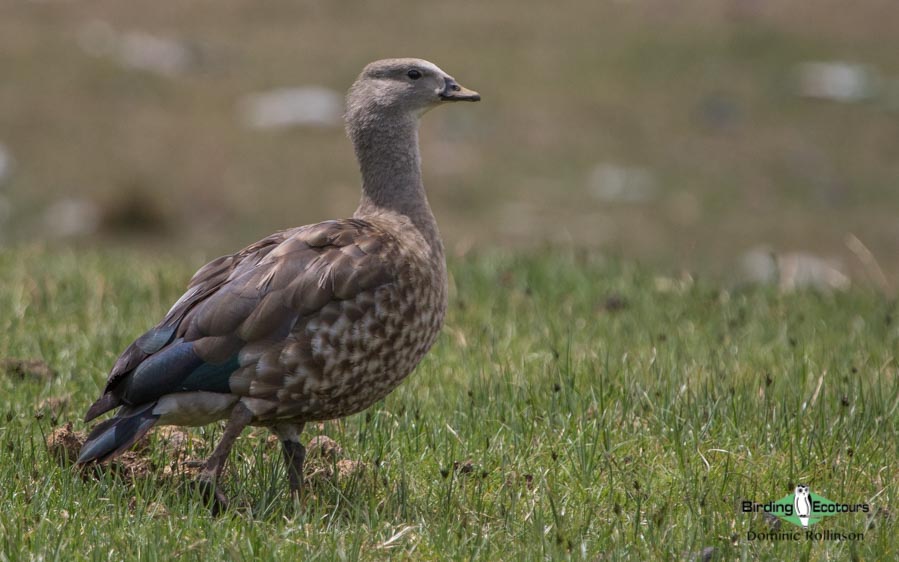
Soon we will be driving on Africa’s highest road, passing close to the summit of Ethiopia’s second highest mountain. Here on the Sanetti Plateau, an island of tundra in the tropics, the habitat is classified as “Afro-alpine moorland”, characterized by a fascinating range of unique plants, including giant lobelias, which tower like monolithic giants over the rich tussock grasslands, and extensive cushions of yellow everlasting flowers. The grasslands are estimated to support an incredible biomass of 8,800 pounds (3,990 kilograms) of rodents per hectare! This obviously attracts a rich array of raptors, and we should see Steppe and Golden Eagles, Augur Buzzard, and the elegant Pallid Harrier circling over this verdant floral sea. They share this abundant food source with the plateau’s most celebrated resident, the Ethiopian Wolf, crowned with the unenviable title of “the world’s rarest canid”. Watching these vibrantly colored animals exhibiting their hunting prowess while pouncing on Giant Mole Rats is surely among Africa’s greatest wildlife experiences.
The plateau also holds the only Afrotropical breeding populations of Ruddy Shelduck, Golden Eagle, and Red-billed Chough. We will also search for Black Stork, Wattled Ibis, Rouget’s Rail (particularly common and confiding here), the endemic Blue-winged Goose, Spot-breasted Lapwing, Wattled Crane, Thekla’s Lark, migratory flocks of Red-throated Pipit, Abyssinian Longclaw, Rusty-breasted Wheatear, the dumpy Moorland Chat, and flocks of the endemic Ethiopian Siskin.
Overnight: Goba Wabe Shebelle Hotel, Goba, or Bale Mountain Lodge
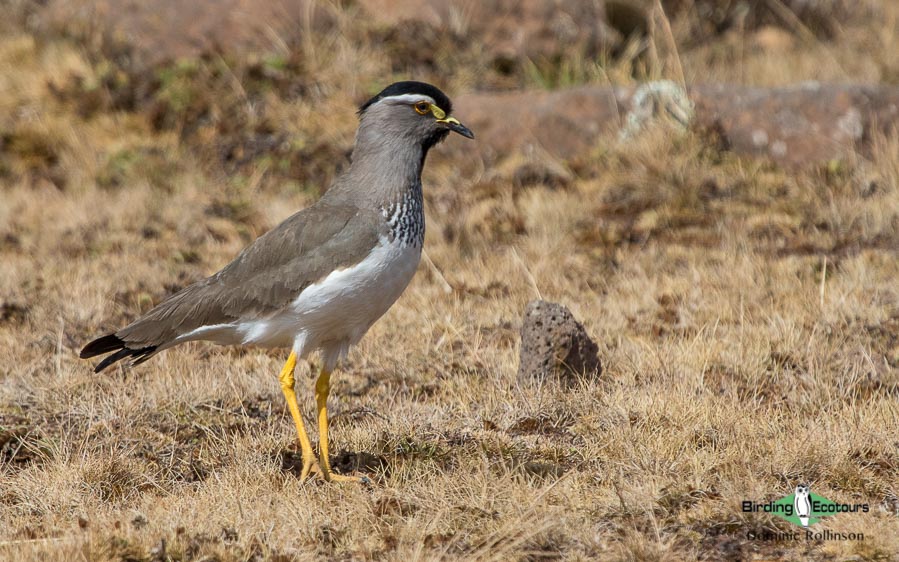
Day 13. Birding the Genale Valley
Today we head south for the Negele area through the interesting, dry Genale Valley. Negele is one of Ethiopia’s great endemic hotspots, and this entire area is brimming with great birds. Among many, many others we could enjoy Brown Snake Eagle, Northern Brownbul, Yellow-breasted Apalis, Grey Tit-Flycatcher, Red-and-yellow Barbet, Upcher’s Warbler, Red-capped Robin-Chat, and Golden-breasted, Superb, Shelley’s, and Violet-backed Starlings. The bird of the day (and perhaps of the trip) is likely to be Ruspoli’s Turaco which we will look for along the Genale River – a true Ethiopian megabird.
Overnight: Maereg Guest House, Negele
Day 14. Birding the Negele area and the Liben Plains
Today we will spend a full day in the Negele area seeking endemics and dry-land birds. Our main target here is the Critically Endangered (BirdLife International) Archer’s Lark, with not many more than 100 individuals left; this species is also known as Liben Lark. We will search for it in the Liben Plains, close to Negele. This and the surrounding area should hopefully also yield a vast number of other desirable species such as Foxy Lark, Somali Short-toed Lark, White-crowned Starling, Shelley’s Sparrow, Reichenow’s Seedeater, the incredibly localized Ethiopian endemic White-tailed Swallow, the handsome Bare-eyed Thrush, Spotted Palm Thrush, Pale Prinia, and Boran Cisticola. Interesting ground birds like Temminck’s Courser, White-bellied Bustard, and Black-faced Sandgrouse might also be encountered.
Overnight: Maereg Guest House, Negele
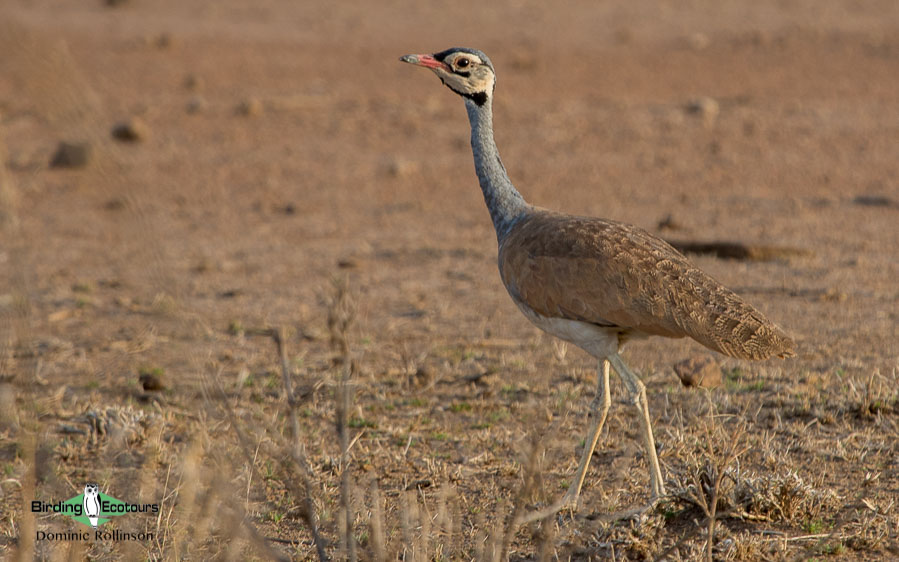
Day 15. Transfer to Yabello
Today will be a long transfer to Yabello while roadside birding should be good and will provide several pleasant stops. We are expecting to add new birds to our burgeoning list, such as Gabar Goshawk, Ovambo Sparrowhawk, and Grey Kestrel, as well as Pearl-spotted Owlet, Black-throated Barbet, D’Arnaud’s Barbet, and Nubian Woodpecker. To many people today may be the highlight of the tour, when we first encounter Stresemann’s Bushcrow. This characterful species might be related to Middle Eastern/Central Asian ground jays, although its taxonomy is puzzling, and it might not even be a corvid at all. Of course, there are a host of other awesome birds to find as well, and this area keeps us as busy as ever. Among others, we might encounter Banded Parisoma, Scaly Chatterer, Acacia Tit, Eastern Violet-backed Sunbird, Hunter’s Sunbird, the striking Magpie Starling, Juba Weaver, White-bellied Canary, Golden-breasted Bunting, the beautifully colored Purple Grenadier, and Grey-capped as well as Black-capped Social Weavers. Time permitting, we will also go on a short night drive.
Overnight: Yabello Motel, Yabello
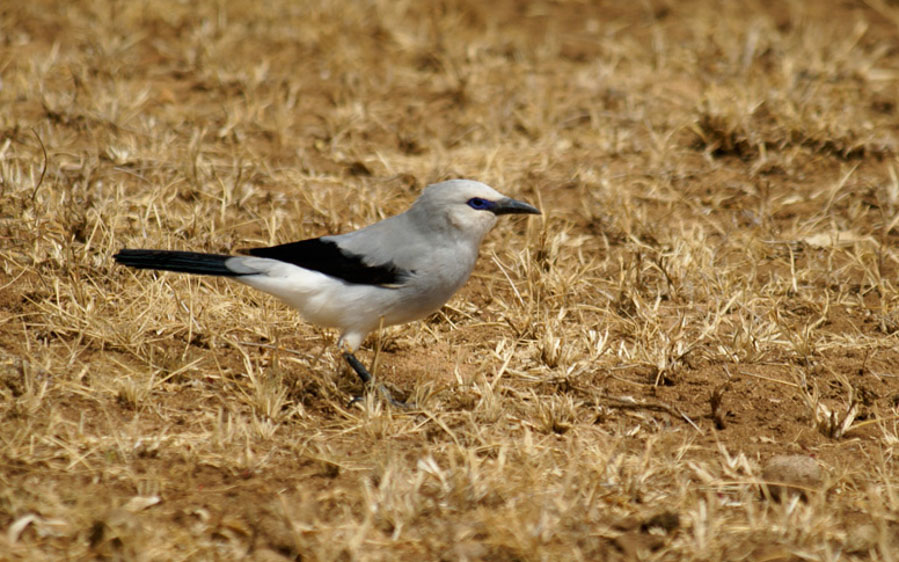
Day 16. Birding the Yabello Wildlife Sanctuary
We’ll have the full day in bushcrow country – but we’ll also look for tons of other birds, such as Somali Courser, Somali Fiscal, Taita Fiscal, Short-tailed Lark, and Red-naped Bushshrike, and also for many less range-restricted species like Speke’s Weaver, Black-faced Waxbill, Black-chested Snake Eagle, Eurasian Hobby, Black Cuckoo, and Steel-blue and Straw-tailed Whydahs. We will also head to an area to look for the localized endemic Salvadori’s Seedeater. As always throughout this epic tour, we should stumble across a plethora of Eurasian migrants, which could include warblers, buntings, and many others. Yabello Wildlife Sanctuary also contains the improbably long-necked Gerenuk, an antelope that feeds high up in trees and bushes while standing on its hind legs. A night drive might yield yet another mammalian treat, the Somali Bushbaby.
Overnight: Yabello Motel, Yabello
Day 17. Yabello to Awassa
We drive to Awassa on the beautiful lake of the same name, where we visit the fascinating Awassa fish market – here an incredible plethora of Hamerkop, Marabou Stork, and Great White Pelican, as well as various gulls and terns and a multitude of others feed on the scraps within meters of people. On the lake we may find our second pelican species, Pink-backed Pelican, and migrant Lesser Black-backed Gulls. We also look for woodland birds here, such as both Eurasian and Red-throated Wrynecks, Western Banded Snake Eagle, Blue-headed Coucal, Red-faced Cisticola, Red-headed Weaver, the beautiful white form of African Paradise Flycatcher, Northern White-faced Owl, and others.
Overnight: United Africa Hotel, Awassa
Day 18. Birding Gibe Gorge
Today is our final full day of Ethiopian birding and we drive to Gibe Gorge with an early departure. This is a beautifully scenic area, which hosts some fabulous and sought-after birds, including Red-billed Pytilia, Yellow-throated Sandgrouse, Vinaceous Dove, Western Black-headed Batis, Bar-breasted Firefinch, and Fawn-breasted Waxbill.
Overnight: Yejoka Hotel, Welkite
Day 19. Transfer to Addis Ababa airport, departure
Our flight leaves Addis Ababa later in the day. We will bird or relax in the hotel grounds at Welkite, going straight to the airport from there. If you are joining us on our Lalibela Cultural Extension, we will spend the night in Addis Ababa before flying out to Lalibela the following morning.
Overnight: Not included (unless you are continuing on extension)
Please note that the itinerary cannot be guaranteed as it is only a rough guide and can be changed (usually slightly) due to factors such as availability of accommodation, updated information on the state of accommodation, roads, or birding sites, the discretion of the guides, and other factors. In addition, we sometimes have to use a different international guide from the one advertised due to tour scheduling
Download Itinerary‘Our birding trip to Ethiopia was fantastic. The country is so rich in history and interesting people and customs. The birding was great! Needless to say Dominic is an expert birder. He is a warm and gracious person and we all really enjoyed his company. Our Ethiopian driver and guide, Tesfaw, was also very good. He was an experienced guide and driver. His contacts were good as were his day to day decisions. He kept our group on time and on schedule but was also flexible to our requests and needs.
We rate our trip excellent( A,10/10). Thank you for all your work in arranging the trip. We appreciate all your prompt correspondences. We certainly will be using Birding Ecotours in the future. We hope to meet you in person some day.’
Lauri and Steve

